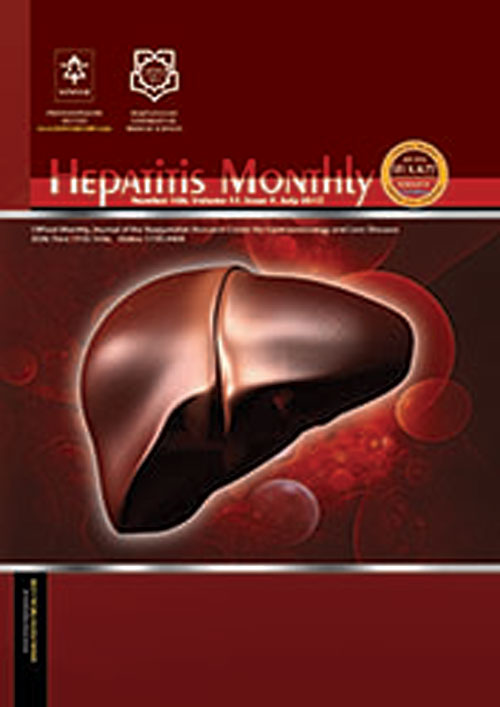فهرست مطالب

Hepatitis Monthly
Volume:19 Issue: 2, Feb 2019
- تاریخ انتشار: 1397/11/16
- تعداد عناوین: 3
-
-
Page 1BackgroundLiver fibrosis and related hepatic dysfunction are among major medical issues in patients with chronic hepatitis B (CHB). It finally may lead to cirrhosis, hepatocellular carcinoma (HCC), and liver-related death.ObjectivesThis study aimed to investigate the effects of adding atorvastatin to the standard antiviral therapy on the hepatic fibrosis and progression of cirrhosis in CHB patients.MethodsIn this double-blinded clinical trial, 77 CHB patients referring to the gastroenterology and hepatology clinics in Qom, Iran, were selected by simple random sampling from 2016 to 2017. The participants were randomly divided into an intervention group that received tenofovir (300 mg) with atorvastatin (20 mg) daily and a control group that received tenofovir (300 mg) and placebo of atorvastatin daily.ResultsAccording to the findings, changes in the aspartate aminotransferase (AST) level were not significant in the control (P = 0.771) and intervention (P = 0.266) groups. Changes in the alanine aminotransferase (ALT) level were non-significant in the control group (P = 0.893) but significant in the intervention group (P = 0.018). Changes in the liver fibrosis were significant in the intervention group (P = 0.001) and between the two groups (P < 0.001).ConclusionsAccording to the study results, adding atorvastatin to the standard antiviral regimen improves the liver function and reduces liver fibrosis in CHB patients. Therefore, it is suggested that atorvastatin be used as complementary therapy.Keywords: Atorvastatin, Liver Cirrhosis, Fibrosis, Hepatitis
-
Page 2BackgroundAccumulating evidence indicates that mitochondrial dysfunction is considered an effective factor in the formation or development of non-alcoholic fatty liver disease (NAFLD) although the underlying mechanisms of the changes are still unclear.ObjectivesThe aim of the study was to determine the 4977-bp deletion levels and variations in the displacement (D) loop region of mitochondrial DNA (mtDNA) in NAFLD patients.MethodsIn this case-control study, 43 NAFLD patients and 156 controls were enrolled. The blood DNA of 43 patients with NAFLD and 156 healthy individuals was investigated to determine the 4977-bp deletion and sequence changes in the D-loop region using methods such as polymerase chain reaction (PCR), multiplex PCR, and DNA sequencing.ResultsThe results indicated that no 4977-bp deletion was found in any of the samples. 94 variations were found in the D-loop region including two deletions, four insertions, and 88 single nucleotide polymorphisms (SNP), 16 of which were just found in patients. There was a significant difference between the NAFLD patients and controls in six variants (P < 0.05). Two novel insertions (16171 ins T and 16221 ins C) were observed in patients. Finally, the results revealed no statistically significant difference (P > 0.05) in C variations in D310 mitochondrial DNA between the two groups.ConclusionsAccording to the findings, we believe that the disease damages the mitochondrial DNA and leads to the formation of these mutations. Our results also showed that D-loop alterations are frequent in NAFLD and may play a significant role in the progression of NAFLD.Keywords: Mitochondrial DNA Displacement Loop, Non-Alcoholic Fatty Liver Disease, Mitochondrial Dysfunction, 4977-bp Deletion
-
Page 3BackgroundChronic infection with hepatitis B virus (HBV) is related to more than 50% of all cases of hepatocellular carcinoma (HCC). The HBx protein of the virus plays an important role in carcinogenesis through different mechanisms, including interaction with the Notch1 signaling pathway. Several microRNAs have also been shown to play essential roles in the carcinogenesis of HCC, and the molecules can be considered the novel biomarkers for the diagnosis of different types of cancer.MethodsIn the present study, the expression levels of four bioinformatically predicted microRNAs, including miR-214, miR-6510, miR-5193, and miR-34a, were compared in individuals with HBV-associated HCC and controls in order to assess the diagnostic utility of these microRNAs as noninvasive biomarkers. Seventy three plasma samples were subjected to RNA extraction, and the microRNA expression profiles were assessed by RT-qPCR. The expression of miR-103 was used as the endogenous reference for the normalization of quantitative data.ResultsThe plasma expression of all miRNAs was significantly lower in the HCC group, but the downregulation was most marked for the newly described molecule, miR-5193 (-18.86 folds and -5.71 folds compared to healthy individuals and chronic HBV patients). Another novel microRNA, miR-6510, was downregulated by -4.23 folds (P = 0.001). The results of the ROC curve analysis indicated that the differential expression of miR-5193 could distinguish HCC patients with high sensitivity and specificity.ConclusionsThe study microRNAs may have a role in HCC development and progression. In addition, miR-5193 can be potentially used as a non-invasive biomarker for the detection of HBV-induced HCC.Keywords: Biomarker, HBV, HCC, Hepatocellular Carcinoma, MicroRNA

